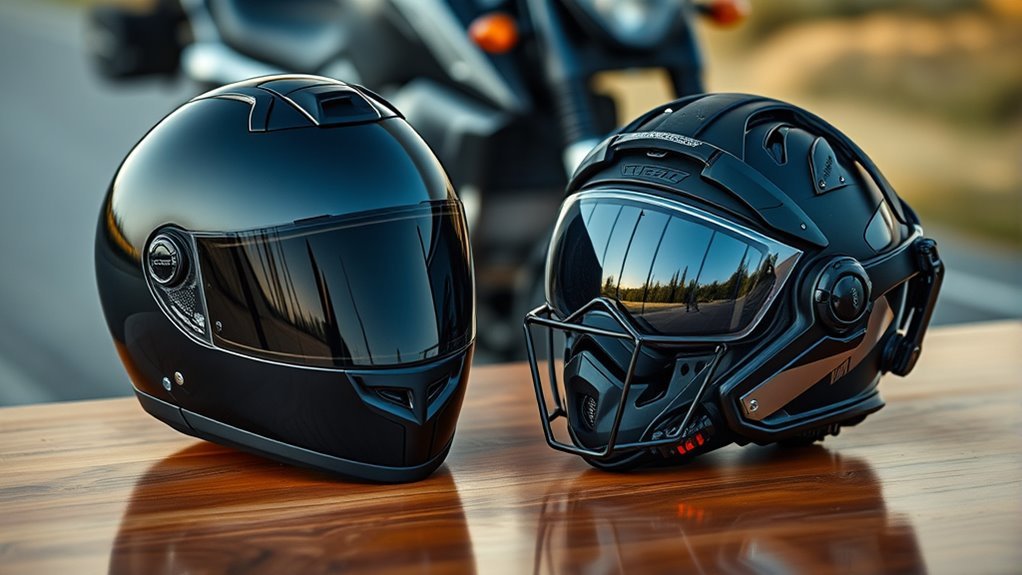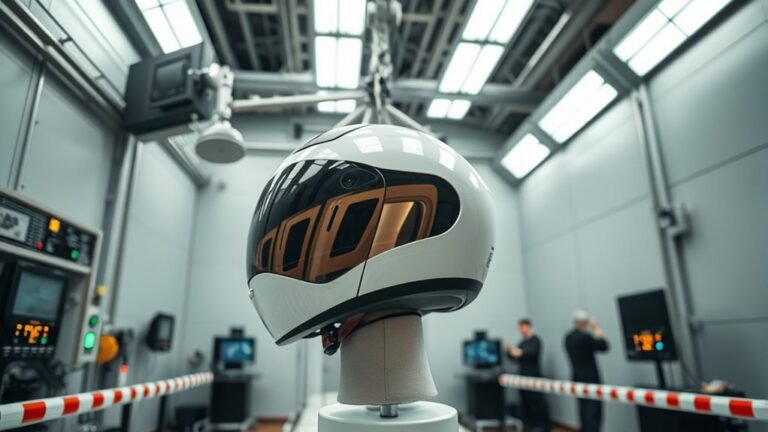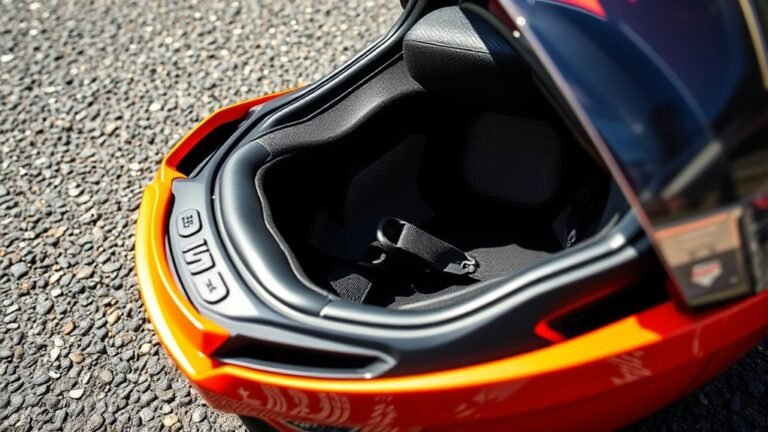Full Face vs. Modular Motorcycle Helmets – Which Is Safer?
When considering safety, full face helmets generally provide superior protection compared to modular helmets. They offer complete coverage for your head, face, and chin, ensuring minimal risk of injury during accidents. While modular helmets allow for more convenience and ventilation, their design may compromise chin protection. It’s essential to evaluate your riding scenario and preferences. To make a well-informed choice, let’s explore the factors that influence helmet safety and comfort.
Understanding Full Face Helmets
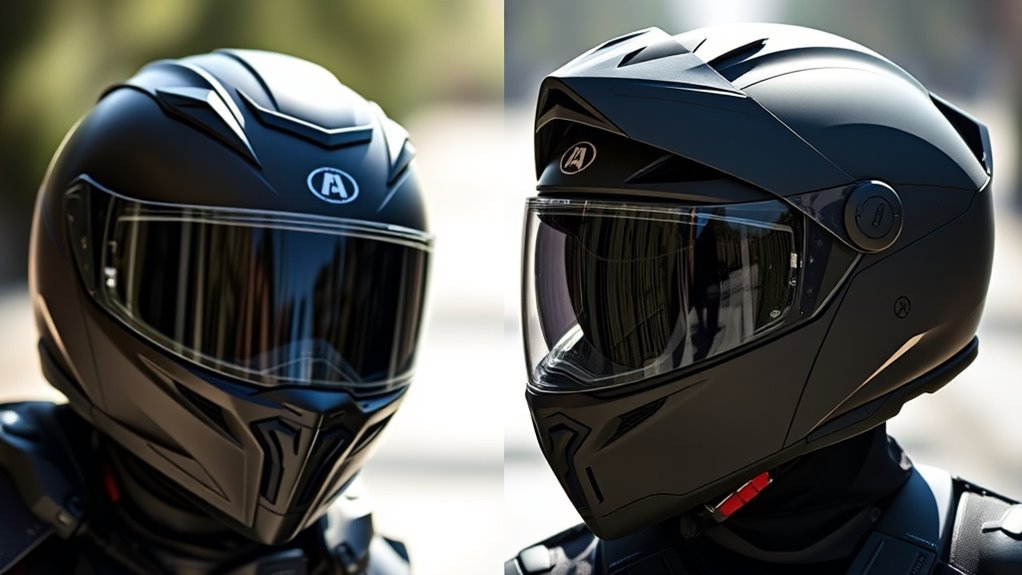
When contemplating safety and protection on the road, understanding full face helmets is vital for any motorcyclist. Full face helmets offer significant benefits, including extensive coverage for your head, face, and chin, which enhances safety during accidents. They also provide superior wind and noise protection, allowing you to enjoy the ride more freely. However, there are full face drawbacks to evaluate. These helmets can feel restrictive and may limit airflow, especially during hot weather. Some riders find them less convenient for communication or quick stops. Weighing these factors is important in deciding whether a full face helmet suits your riding style and safety needs. Ultimately, the choice hinges on balancing freedom with the level of protection you desire.
Understanding Modular Helmets
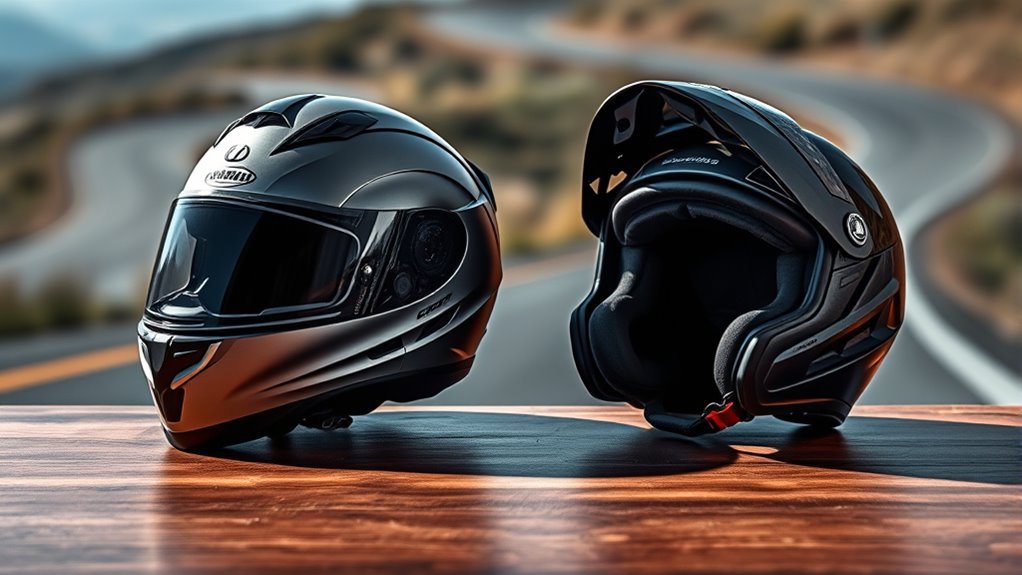
While full face helmets are renowned for their protective features, modular helmets present a versatile alternative that caters to a variety of riding preferences. The modular design allows you to flip up the front of the helmet, giving you the freedom to interact more easily with your surroundings. This feature makes modular helmets particularly appealing for riders who value convenience during short stops or conversations. Additionally, they combine the benefits of both full face and open face helmets, offering a balance between protection and comfort. However, this versatility might come at the cost of slight weight increases compared to full face options. Ultimately, understanding the unique attributes of modular helmets can help you make an informed decision that aligns with your riding style.
Safety Ratings and Standards
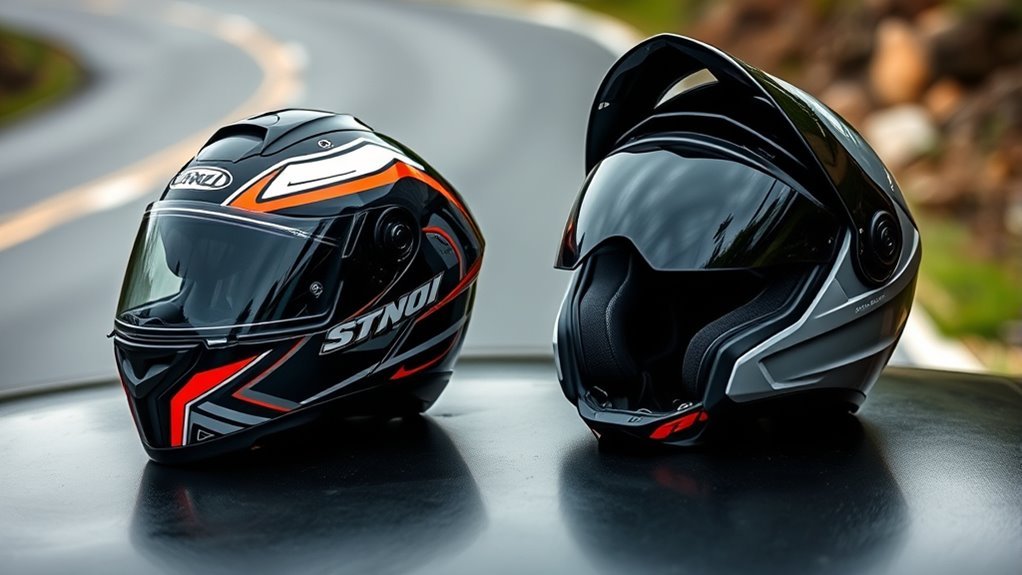
When choosing a motorcycle helmet, understanding safety ratings and standards is essential. You’ll want to take into account impact protection levels, which indicate how well a helmet can absorb force during a crash, along with safety certification standards that guarantee compliance with industry requirements. Additionally, factors like ventilation and visibility can greatly affect your overall safety while riding.
Impact Protection Levels
Safety is paramount in motorcycle riding, and understanding impact protection levels is essential for choosing the right helmet. The effectiveness of a helmet largely depends on its materials and design, which influence its impact absorption capabilities. Full face helmets generally offer superior protection due to their solid structure, whereas modular helmets may compromise on this front due to their hinged design. Here’s a comparison of impact protection levels:
| Helmet Type | Impact Absorption Level | Common Materials |
|---|---|---|
| Full Face | High | Polycarbonate, Fiberglass |
| Modular | Moderate | Thermoplastic, Composite |
| Off-Road | Variable | Carbon Fiber, Kevlar |
| Open Face | Low | Plastic, EPS Foam |
| Half Helmet | Minimal | Hard Foam, ABS |
Make informed choices for your freedom on the road!
Safety Certification Standards
How can you guarantee that your motorcycle helmet meets the necessary safety standards? To verify your helmet complies with crucial safety regulations, look for certifications from recognized certification bodies like DOT, ECE, or Snell. Each of these organizations conducts rigorous testing to evaluate impact resistance, penetration, and retention system performance. A helmet bearing these certifications indicates it’s passed critical safety tests, giving you the confidence to ride freely.
When comparing full face and modular helmets, consider how the safety certifications reflect their design and intended use. While both types can meet safety standards, the full face typically offers better coverage and protection. Ultimately, checking for these certifications is fundamental to make an informed choice for your safety on the road.
Ventilation and Visibility Safety
Many riders might not realize that ventilation and visibility are essential factors in helmet safety. A helmet’s ventilation efficiency directly impacts your comfort and ability to focus on the road. Poor airflow can lead to overheating, which might distract you from riding safely. When it comes to visibility range, full-face helmets generally offer better peripheral vision compared to modular helmets. However, modular designs can provide increased flexibility for communication and comfort. It’s vital to balance these aspects, as a helmet that lacks adequate ventilation or visibility can compromise safety during rides. Ultimately, choosing a helmet that optimizes both ventilation efficiency and visibility range allows you to enjoy the freedom of the open road while prioritizing your safety.
Impact Protection and Coverage
While both full face and modular helmets offer vital protection, their impact coverage varies greatly. Full face helmets provide superior impact absorption, enveloping your entire head and face, which enhances structural integrity during crashes. This design minimizes exposure to external forces, markedly reducing the risk of facial injuries. In contrast, modular helmets, while versatile, often compromise on coverage. Their hinged design can create weak points, potentially diminishing the effectiveness of impact protection. When you’re looking for maximum safety on the road, it’s essential to take into account how each helmet type handles impacts. Ultimately, if you’re prioritizing thorough protection, a full face helmet is likely the safer choice, providing a more robust shield against the unexpected.
Ventilation and Comfort Features
When considering ventilation and comfort features, it’s crucial to recognize that full face and modular helmets cater to different riding experiences. Full face helmets typically have advanced ventilation systems, designed to reduce fogging and keep you cool during long rides. These systems often include multiple air vents that can be adjusted to suit your preferences. On the other hand, modular helmets offer a blend of protection and versatility, featuring ventilation systems that can be less efficient due to their design. However, they do provide the benefit of being able to lift the chin bar, increasing airflow when needed. Ultimately, your choice should reflect your comfort needs and riding style, ensuring you enjoy the freedom of the open road without compromising on comfort.
Real-World Performance and User Experience
As riders navigate diverse conditions and scenarios, the real-world performance of full face and modular helmets becomes evident in their functionality and user experience. User feedback often highlights the superior helmet comfort of full face models during long rides, offering a snug fit that minimizes wind resistance. In contrast, modular helmets provide versatility, allowing for easy shifts between full coverage and open-face configurations, which some riders appreciate for convenience during stops. However, many users express concerns about the potential for increased noise and reduced aerodynamic efficiency with modular designs. Ultimately, your choice may depend on personal preferences for comfort and convenience, as well as the specific riding situations you encounter most frequently on your journeys.
Making the Right Choice for Your Riding Style
How do you determine which helmet best suits your riding style? The choice between full face and modular helmets largely hinges on your personal preference and how you ride. If you’re a sport or touring rider seeking maximum protection and aerodynamics, a full face helmet may be ideal. It offers a solid shield against wind and debris, enhancing your freedom on the open road. Conversely, if you often ride in urban settings or enjoy socializing at stops, a modular helmet allows for easy chin bar lifting, providing convenience without sacrificing safety. Consider your typical riding scenarios, comfort, and the level of protection you need. Ultimately, selecting the right helmet should align with your riding style and enhance your overall riding experience.
Frequently Asked Questions
Can I Wear Glasses With a Full Face Helmet?
Yes, you can wear glasses with a full face helmet. Many designs accommodate glasses compatibility, ensuring you can enjoy a comfortable ride without sacrificing vision. When choosing a helmet, look for features like wider eye ports or specific cutouts that prevent pressure on your frames. This way, you’ll have both the freedom to ride and the comfort of clear sight. Just make sure to try it on to find the best fit for your needs.
How Do I Properly Clean and Maintain My Helmet?
Did you know that regular helmet maintenance can extend its lifespan by up to 50%? To properly clean and maintain your helmet, use gentle helmet cleaning techniques, like mild soap and water for the exterior. For the interior, remove and wash the padding regularly. Always check for cracks or wear, and store your helmet in a cool, dry place. These helmet maintenance tips will help guarantee your gear stays safe and effective for your rides.
Are Modular Helmets Quieter Than Full Face Helmets?
Modular helmets can be quieter than full face helmets, but it really depends on their design. Noise levels often vary based on the materials used and the fit of the helmet. A well-designed modular helmet may minimize wind noise while still allowing for versatility, but a full face helmet generally offers better sound insulation due to its enclosed structure. Ultimately, choosing the right helmet comes down to your personal preference and riding style.
What Is the Lifespan of a Motorcycle Helmet?
A motorcycle helmet typically lasts about five years, but isn’t that ironic? You trust your life to something that could wear out faster than your favorite pair of shoes. Helmet materials like polycarbonate or fiberglass are designed to meet safety standards, but exposure to sunlight, humidity, and temperature changes can weaken them over time. So, while you crave freedom on the road, remember to check your helmet regularly and replace it when needed.
Can I Customize the Fit of My Helmet?
Yes, you can customize the fit of your helmet. Many helmets come with adjustable straps and removable helmet padding, allowing you to tailor it for comfort and security. It’s crucial to achieve a snug fit that doesn’t compromise safety. By adjusting the straps and rearranging the padding, you can verify the helmet sits correctly on your head, providing the best protection while you enjoy the freedom of the open road.
